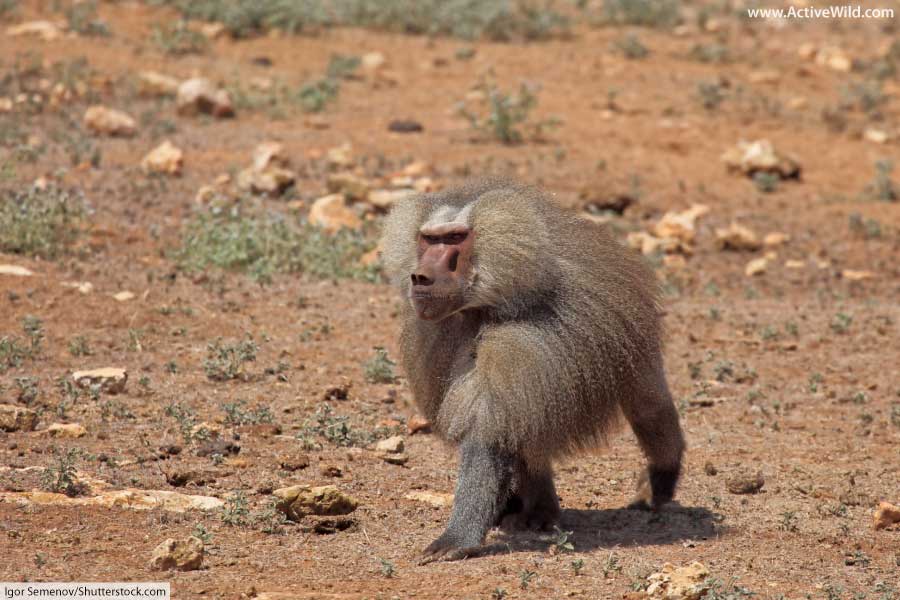
Examples of omnivores include mammals such as baboons, bears, badgers, foxes, raccoons and monkeys; reptiles such as sea turtles and the common snapping turtle; and birds such as crows and other passerines, sapsuckers and the kea.
This page contains examples of omnivores, including these and many more omnivorous species.
Use the index below to find information on a particular animal, or continue scrolling to browse all of the animals on the list.
Omnivores Examples
- Baboons
- Bears
- Brown Rat
- Chimpanzee
- Coati (South American)
- Common Snapping Turtle
- Crabs
- Crows
- Earthworms
- European Badger
- Honey Badger
- Kea
- Mallard
- Maned Wolf
- Marmosets
- Raccoon
- Red Fox
- Sapsuckers
- Sea Turtles
- Skunks
- Sloths (Two-Toed)
- Squirrel Monkeys
- Virginia Opossum
- Warthogs
- Wild Boar
Omnivores
An omnivore is a species whose diet consists of a mixture of both plant and animal matter. The ability to survive on a wide variety of food can be advantageous to omnivorous animals; it is partly due to the omnivorous diet of animals such as rats, foxes and dogs that they have been able to spread over the world with humans (which, of course, are another omnivorous species).
Below is a list of notable omnivorous animals from a variety of animal groups.
Baboons

- Genus: Papio
- Type of animal: Mammal
- Family: Cercopithecidae
- Where found: Africa
Baboons are large monkeys of genus Papio, which is part of the family Cercopithecidae – a group of primates known as the “Old World monkeys”.
Unlike most monkeys, baboons are terrestrial (ground-dwelling), rather than arboreal (tree-dwelling).
The six species of baboon are listed below, together with the conservation status of each. All are found in Africa; the hamadryas baboon is also found on the Arabian Peninsula.
- Hamadryas baboon Papio hamadryas Least Concern
- Guinea baboon Papio papio Near Threatened
- Olive baboon Papio anubis Least Concern
- Yellow baboon Papio cynocephalus Least Concern
- Chacma baboon Papio ursinus Least Concern
- Kinda baboon Papio kindae Least Concern
Baboons are omnivores that eat a wide range of food, from grass and fruit to small antelopes and even other monkeys.
Discover More With Active Wild
- You can find out more about the olive baboon on this page: Olive Baboon Facts
- You can find out more about baboons on this page: Baboon Facts
- Discover different types of monkeys on this page: Types of Monkeys
- You can find out more about primates on this page: Primates – Ultimate Guide
Bears
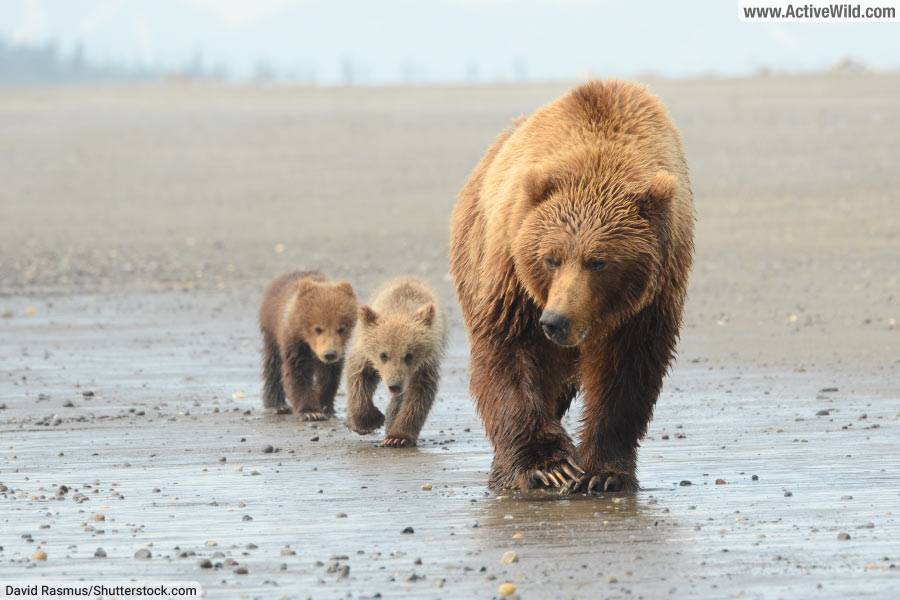
- Type of animal: Mammal
- Family: Ursidae
- Where found: All continents except Antarctica
The eight species of bear are the: polar bear, brown bear, American black bear, spectacled bear, Asian black bear, sloth bear, sun bear, and giant panda. Together, they make up the family Ursidae.
Bears are often used as examples of omnivores. Most bears are omnivorous to a greater or lesser degree, with species such as the brown bear and American black bear being among the world’s most omnivorous animals, able to either forage, scavenge or hunt a wide variety of food.
Other bears are less omnivorous. The polar bear, for example, is almost entirely carnivorous, while the giant panda is mainly herbivorous.
Discover More With Active Wild
- You can see pictures and facts on EVERY species of bear on this page: Types Of Bears
- Discover more about bears on this page: Bears – The Ultimate Guide
Brown Rat
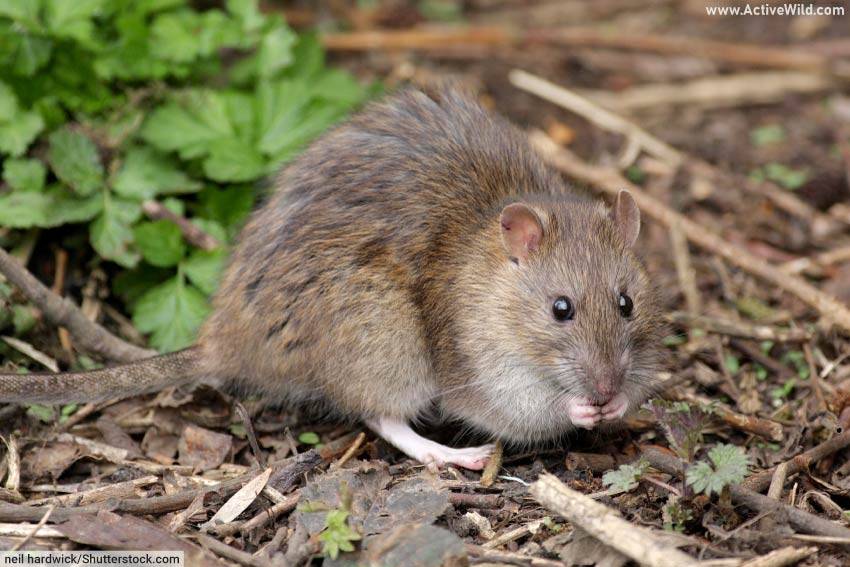
- Scientific name: Rattus norvegicus
- Type of animal: Mammal, Rodent
- Family: Muridae
- Where found: All continents except Antarctica
- Conservation status: Least Concern
Like all “true” rats, the brown rat is a rodent of genus Rattus, a group of rodents that contains 66 currently-recognized species. (Several other animals, such as bandicoot rats, are called “rats” but are not actually “true” rats.)
The brown rat is a common and widespread animal, found wherever humans live, on all continents except Alaska.
One of the largest members of the rat and mouse family Muridae, the brown rat can weigh almost twice as much as the black rat, another widespread (and herbivorous) rat.
The brown rat can thrive in many different habitats and climates due partly to its omnivorous diet. The brown rat will eat almost anything, from cereals to small animals.
Discover More With Active Wild
- You can find out more about rodents on this page: Rodents – The Ultimate Guide
Chimpanzee
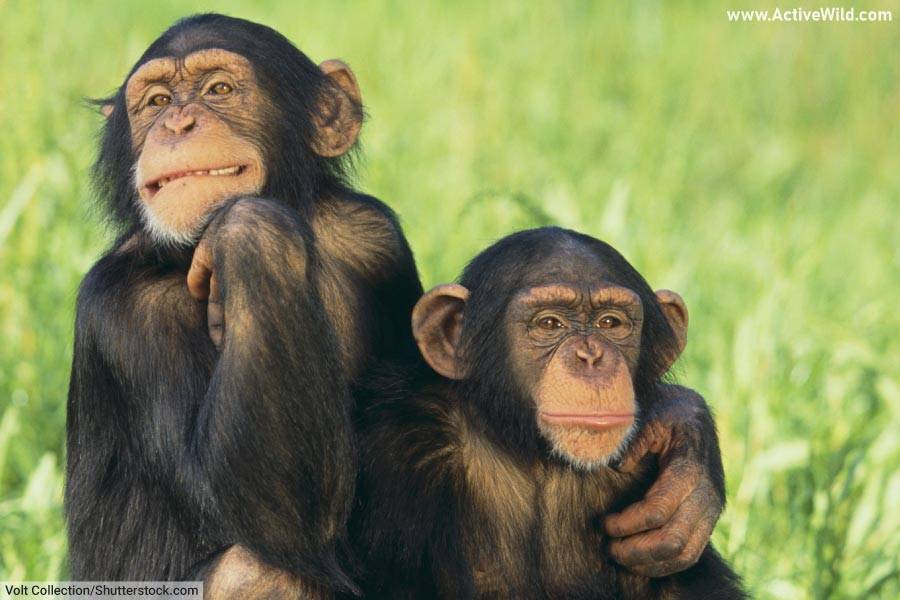
- Scientific name: Pan troglodytes
- Type of animal: Mammal, Primate
- Family: Hominidae
- Where found: Africa
- Conservation status: Endangered
Chimpanzees are primates found in the forests of central Africa. They are our nearest living relatives, sharing around 98% of our genes. They belong to the great ape family Hominidae, along with bonobos, gorillas, orangutans and humans.
These intelligent apes are among the very few animals known to use tools. Chimpanzees have been observed using sticks to extract insects such as termites and bees from their nests, and stones to crack open nuts.
Although the majority of a chimp’s diet is fruit and other plant material, the species also eats insects, eggs, and small animals.
Discover More With Active Wild
- You can find out more about chimpanzees on this page: Chimpanzee Facts
- You can find out more about primates on this page: Primates – Ultimate Guide
Coati (South American)

- Scientific name: Nasua nasua
- Type of animal: Mammal
- Family: Procyonidae
- Where found: South America
- Conservation status: Least Concern
The South American coati is one of four species of coati. These cat-sized omnivorous mammals belonging to the raccoon family, Procyonidae. Coatis are also known as coatimundis.
The South American coati forages on the forest floor by day, finding food among the leaf litter using its acute sense of smell. During the night it sleeps in the forest canopy.
Discover More With Active Wild
- You can find out more about the South American coati on this page: South American Coati Facts
Common Snapping Turtle
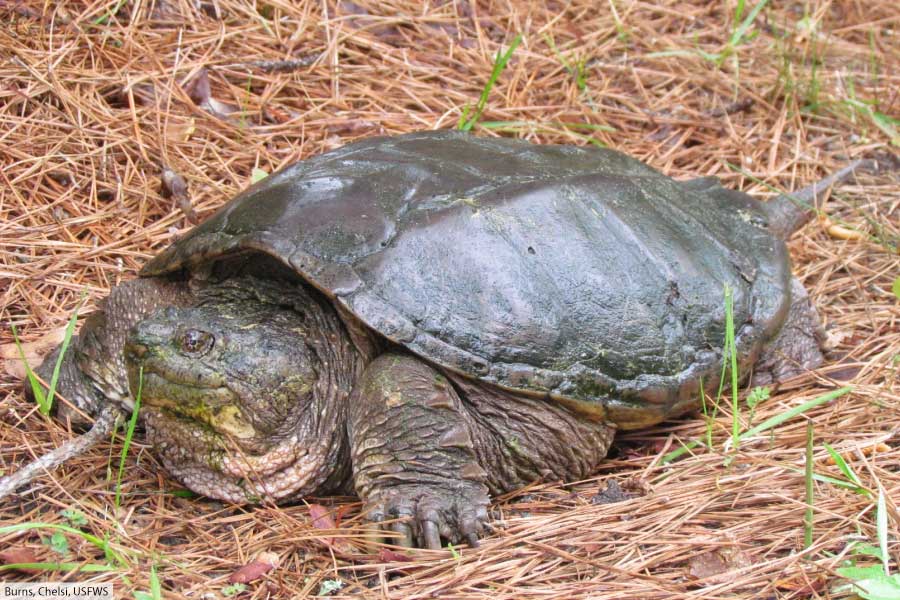
- Scientific name: Chelydra serpentina
- Type of animal: Reptile
- Family: Chelydridae
- Where found: North America (introduced to parts of Asia)
- Conservation status: Least Concern
The common snapping turtle is the most widespread of the three snapping turtles of genus Chelydra, and the only one found in the United States and Canada.
As an egg and hatchling, the snapping turtle has numerous predators, but as an adult it is relatively safe from predation. Only bears, alligators, and occasionally river otters have been documented preying on adult snappers.
An omnivore, the common snapping turtle eats large amounts of aquatic plants, as well as foraging for carrion and actively hunting numerous animals, including waterfowl and small mammals. It usually employs an ambush strategy, waiting for its prey to draw near before launching an attack.
The common snapping turtle has a maximum carapace (shell) length of 50 cm / 19 inches, and a maximum weight of 35 kg / 77 lb., although the average individual is significantly smaller. The species’ tail is almost as long as its shell.
Discover More With Active Wild
- You can see more North American reptiles on this page: American Reptiles List with Pictures & Interesting Facts
- Discover different types of turtles on this page: Types of Turtles
Crabs
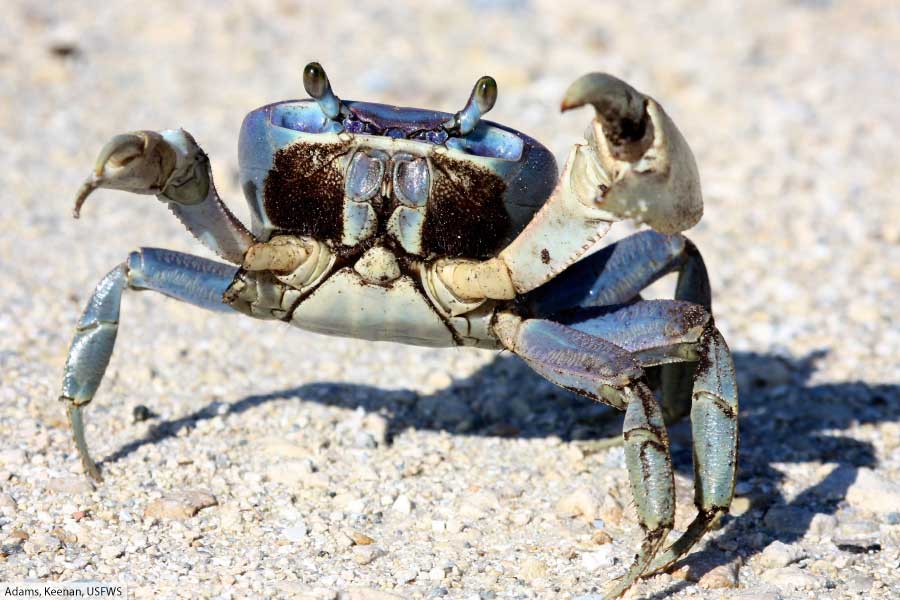
- Type of animal: Crustacean
- Infraorder: Brachyura
- Where found: Oceans worldwide
Crabs are crustaceans with armored exoskeletons and ten legs, the front two of which are equipped with pincers.
Most crabs walk sideways, and the hind legs of some crabs have evolved into flattened “paddles” for swimming.
Crabs are found in all of the world’s oceans, and are also found in freshwater and even on land. The world’s largest crab is the Japanese spider crab, whose leg span can be a length of up to 4 meters (13 ft.)
Discover More With Active Wild
- You can find out more about crustaceans on this page: Crustaceans – The Ultimate Guide
Crows

- Order: Passeriformes
- Family: Corvidae
The crow family Corvidae contains not only crows but also birds such as jays, nutcrackers, ravens and magpies. Members of Corvidae are known as “corvids”, and are found on all continents apart from Antarctica.
Corvids are part of a larger group of birds, the order Passeriformes, whose members are known as Passerines, or “Perching birds”. Like most passerines, crows are omnivores.
Crows are among the most intelligent of all animals. Several crow species have been observed using “tools” such as sticks to acquire food, and the Eurasian magpie is one of the few animals able to pass the mirror test for self-awareness.
The common raven is not only the largest member of the crow family, but also the largest passerine.
Discover More With Active Wild
- You can find out more about ravens on this page: Raven Facts
- Test your knowledge of British birds with our free Android app: British Birds ID Quiz
- Test your knowledge of North American birds with our free Android app: North American Birds ID Quiz
Earthworms
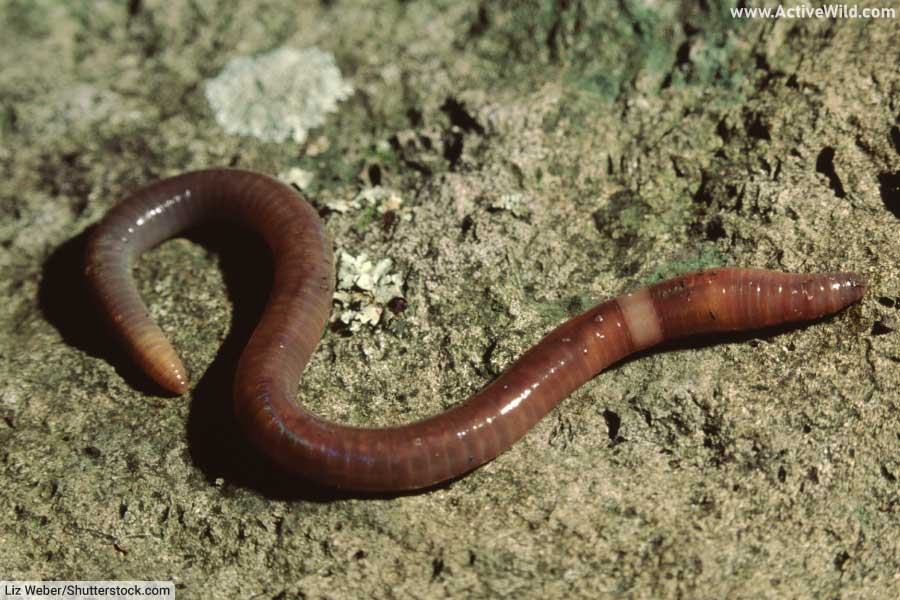
- Type of animal: Annelid
- Phylum: Annelida
- Where found: All continents except Antarctica
Earthworms are long, tubular invertebrates belonging to the order Opisthopora. There are over 6,000 known species of earthworm, and they found on all continents except Antarctica.
Earthworms eat a variety of plant and animal material found in the soil. The animal part of an earthworm’s diet includes animals such as nematodes (roundworms) and rotifers.
Protruding from each segment of an earthworm’s body are small bristles known as setae. An earthworm moves by expanding and contracting its body, with the setae acting as anchors as the worm pushes and pulls.
Earthworms don’t have lungs (they “breathe” through their skin) or eyes (they have light-sensing cells in their skin).
Earthworms are hermaphrodites (their body contains both male and female parts), and some earthworm species are parthenogenic (capable of producing offspring without a partner).
(A searchable database of all earthworm species can be found here.)
Discover More With Active Wild
- Discover the different types of animals on this page: Types of Animals
European Badger
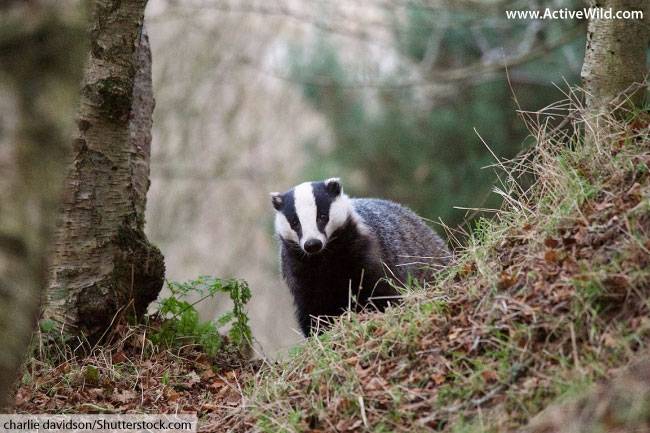
Scientific Name: Meles meles
Type of Animal: Mammal
Family: Mustelidae
Conservation Status: Least Concern
The European badger is the world’s largest badger species. With its black and white markings, the species is one of Europe’s most recognizable animals.
Like many badgers, the European badger is an omnivore. Its diet includes earthworms, small mammals, insects, fruit and grasses.
The European badger is found in woodlands throughout Europe, living in groups in dens known as setts. Like most other badgers, it is mainly nocturnal.
Discover More With Active Wild
- You can find out more about nocturnal animals on this page: Nocturnal Animals
- Discover more black and white animals on this page: Black and White Animals
- You can see more European animals on this page: European Animals
Honey Badger
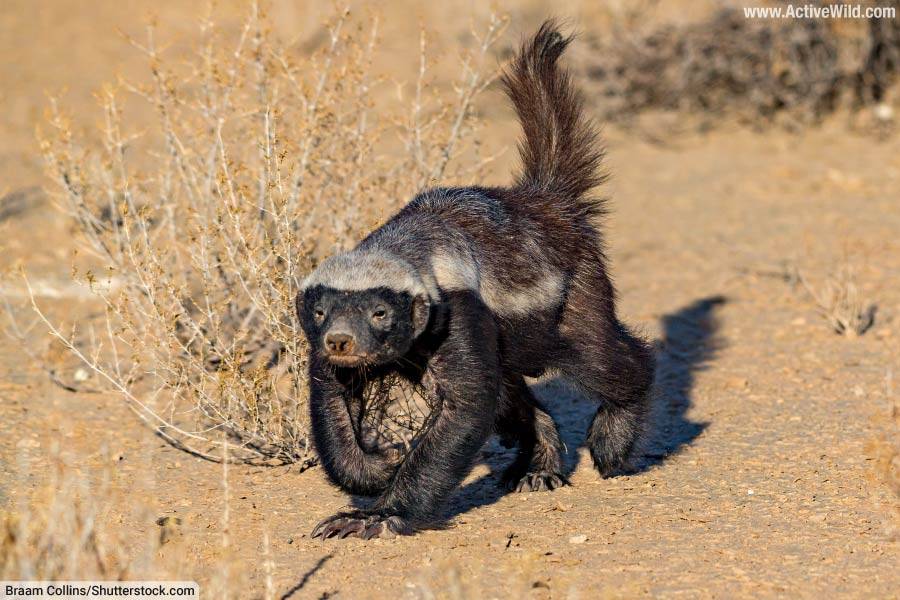
- Type of animal: Mammal
- Family: Mustelidae
- Scientific name: Mellivora capensis
- Conservation status: Least Concern
The honey badger is a member of the weasel family, Mustelidae. This group of carnivoran mammals also includes animals such as otters, weasels, and the wolverine.
Found throughout much of Africa and in parts of Asia, the honey badger is an adaptable species, able to live in a variety of habitats ranging from rainforests to deserts.
Like most badgers, the honey badger is omnivorous. The species is an active hunter, but will also scavenge when the chance presents itself. As its name suggests, the honey badger feeds on honey, and will also eat berries and other plant material.
The honey badger is known for its toughness and willingness to take on animals much larger than itself. Despite its fearsome reputation, however, the honey badger is not an apex predator and will itself fall victim to larger predators such as lions, leopards and hyenas.
Discover More With Active Wild
- You can find out more about the honey badger on this page: Honey Badger Facts
- You can see more African animals on this page: African Animals
Kea
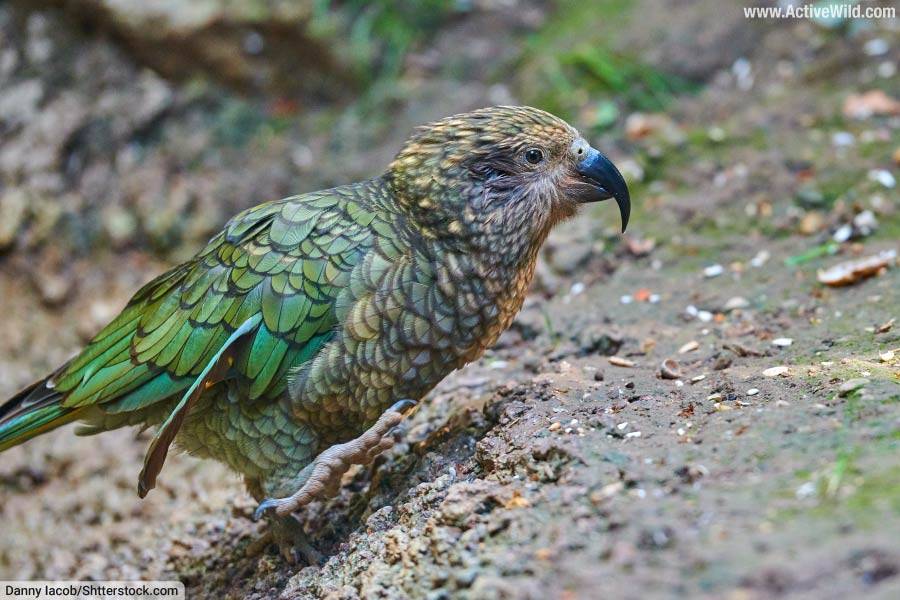
- Scientific name: Nestor notabilis
- Type of animal: Bird
- Family: Strigopidae
- Where found: New Zealand
- Conservation status: Endangered
The kea is a member of the New Zealand parrot family, Strigopidae (although some zoologists place it in the family Nestoridae).
The New Zealand parrots evolved in isolation since New Zealand broke away from the supercontinent Gondwana 80 million-odd years ago. Today, only three species survive: the kea, kākā and Kākāpō, a critically endangered, flightless parrot.
The kea lives in forests in New Zealand’s South Island. The omnivorous parrot feeds on a variety of plants, as well as on animals such as insects, snails, birds and even mammals as large as sheep.
The kea is endangered, in part due to historic persecution by humans as a result of the bird’s attacks on livestock.
Discover More With Active Wild
- You can find out more about birds on this page: Birds – The Ultimate Guide
- Discover different types of birds on this page: Types of Birds
Mallard
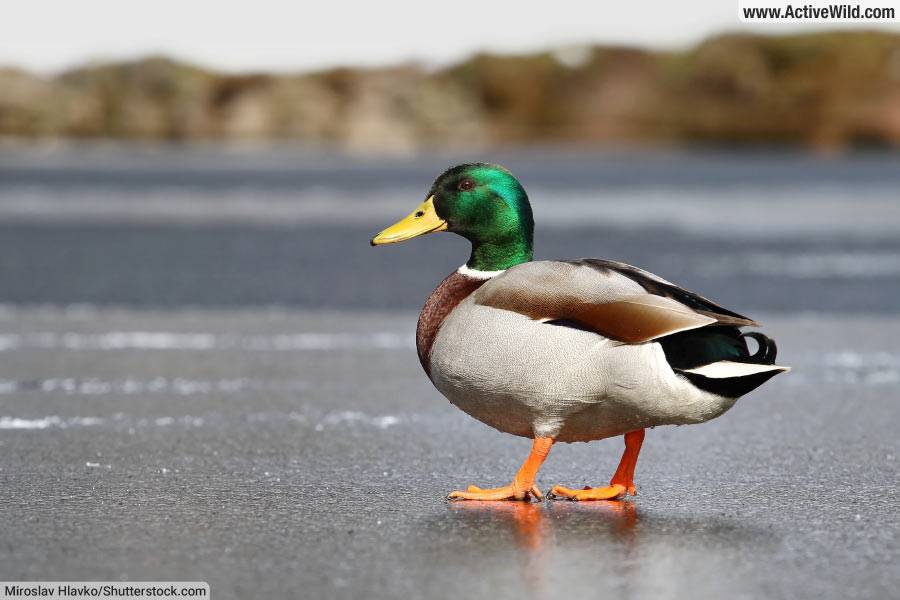
- Scientific name: Anas platyrhynchos
- Type of animal: Bird
- Family: Anatidae
- Where found: Europe, North America, Africa, Australia (introduced)
- Conservation status: Least Concern
The mallard is a species of duck found in most parts of the Northern Hemisphere (the species has also been introduced into Australia).
Due to its wide range and ability to live in urban environments, the mallard is one of the world’s best-known birds. If you’ve ever fed bread to the ducks on the pond at your local park, the chances are they were mallards!
As is the case with many ducks, the male mallard is significantly more colorful than the female, having a metallic green head and a deep brown chest. The female is a variety of brown shades. Both male and female mallards have a flash of blue on their wings.
The mallard is a “dabbling duck”. Instead of diving, dabbling ducks submerge their heads while tilting their bodies forward in order to find food under the water.
The mallard is an omnivore, varying the plant / meat ratio of its diet depending on the time of year.
Discover More With Active Wild
- Discover different types of birds on this page: Types of Birds
- You can find out more about birds on this page: Birds – The Ultimate Guide
- Test your knowledge of British birds with our free Android app: British Birds ID Quiz
- Test your knowledge of North American birds with our free Android app: North American Birds ID Quiz
Maned Wolf
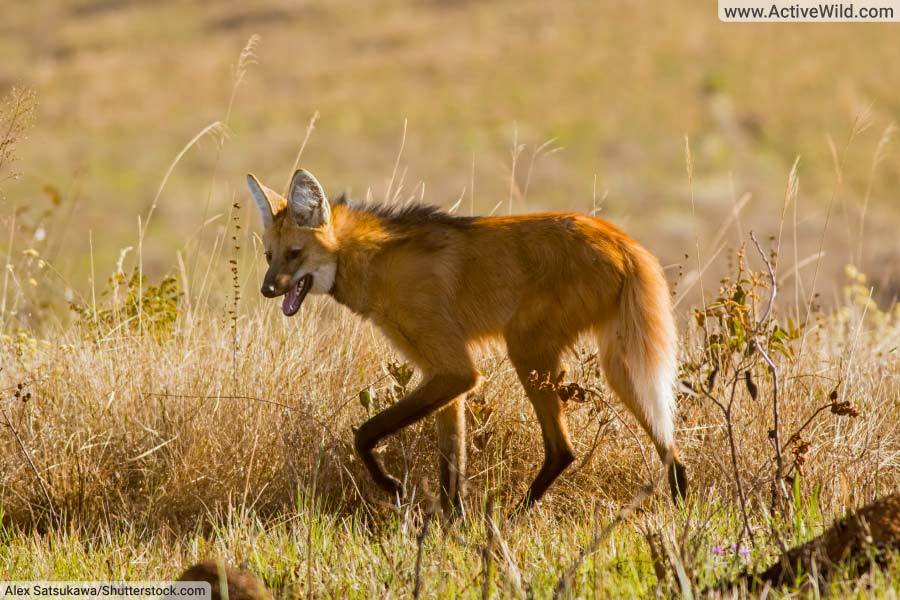
- Scientific Name: Chrysocyon brachyurus
- Type of Animal: Mammal
- Family: Canidae (the dog family)
- Conservation Status: Near Threatened
The maned wolf is a canid (member of the dog family, Canidae) found in the grasslands of central South America. It is both the largest canid found in South America, and the tallest of all wild dogs. This distinctive species has a shaggy, red-brown coat, long legs and large ears.
Despite the name, the maned wolf is not a wolf. A true omnivore, as well as preying on a variety of mammals and other vertebrates, the maned wolf also eats a large amount of plant material – far more than the mainly carnivorous gray wolf.
Discover More With Active Wild
- You can see EVERY species of dog on this page: Wild Dog Species List with Pictures and Facts
- Discover more grassland animals on this page: Grassland Animals Pictures & Facts
- You can see more South American animals on this page: South American Animals
Marmosets
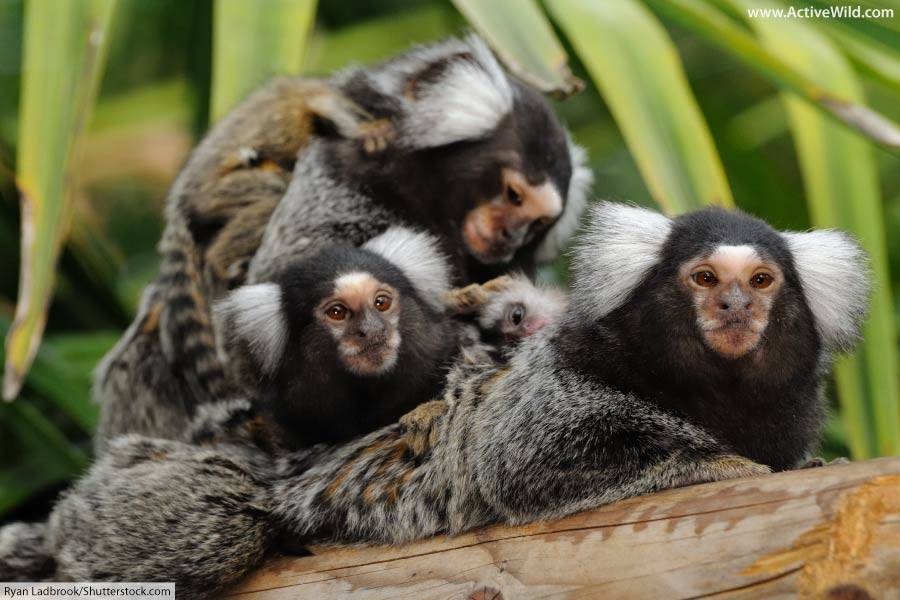
- Type of animal: Mammal (Primate)
- Family: Callitrichidae
- Where found: South America
Twenty-two species of marmoset are currently recognized. They belong to the family Callitrichidae, a group of New World monkeys that is also home to tamarins.
Marmosets are small monkeys that climb trees in a manner similar to that of squirrels. They are relatively primitive monkeys, with claws instead of nails.
Like many monkeys, marmosets are omnivores. They eat tree sap, fruit, eggs, and a variety of small animals.
Discover More With Active Wild
- You can see more rainforest animals on this page: Rainforest Animals List with Pictures & Facts
- You can find out more about monkeys on this page: Monkeys – The Ultimate Guide
- Discover different types of monkeys on this page: Types of Monkeys
- You can find out more about primates on this page: Primates – Ultimate Guide
Raccoon

- Scientific name: Procyon lotor
- Type of animal: Mammal
- Family: Procyonidae
- Where found: North America
- Conservation status: Least Concern
With its distinctive black and white face, the raccoon is one of the most familiar North American mammals. Originally found in forests, the adaptable raccoon is now home in a variety of habitats, including towns and cities.
The raccoon’s success is due in part to its omnivorous diet, which includes insects, worms, the eggs of both birds and reptiles, fish, and occasionally birds and mammals.
Discover More With Active Wild
- You can find out more about raccoons on this page: Raccoon Facts
- You can see more North American animals on this page: North American Animals
- You can see more black and white animals on this page: Black and White Animals
Red Fox
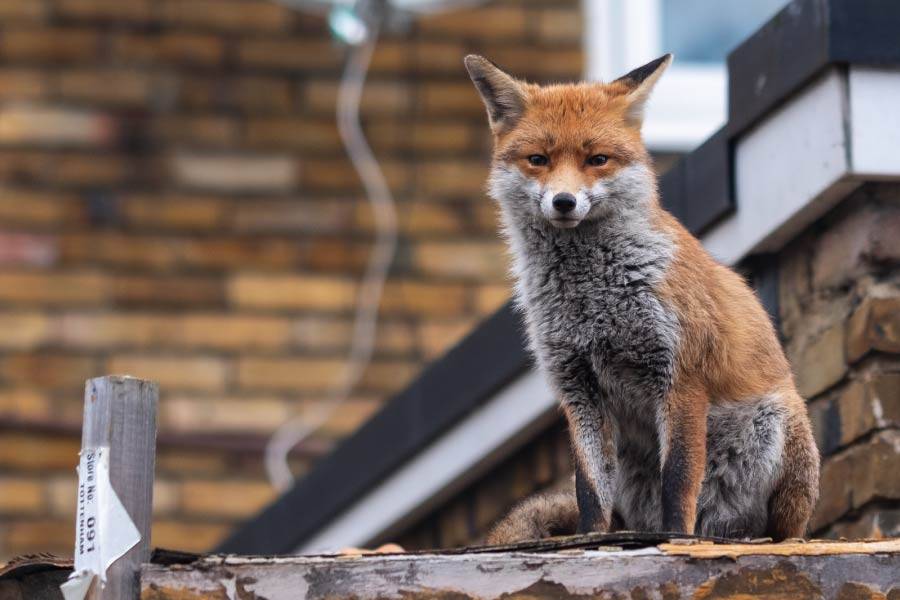
- Scientific Name: Vulpes vulpes
- Type of Animal: Mammal
- Family: Canidae
- Conservation Status: Least Concern
The red fox is one of the most widespread of all members of the dog family Canidae, being found not only throughout Europe, but also in Asia and North America. Part of the species’ success is due to its ability to live alongside humans in urban environments.
As well as being able to live in a wide range of habitats, this adaptable animal is also able to eat a wide range of food. An omnivore, it will catch its own prey (usually small vertebrates such as rodents, rabbits and birds), scavenge, and also eat plant matter such as berries, acorns and grasses.
Discover More With Active Wild
- You can see EVERY species of dog on this page: Wild Dog Species List with Pictures and Facts
- You can find out more about mammals on this page: Mammals – The Ultimate Guide
Sapsucker
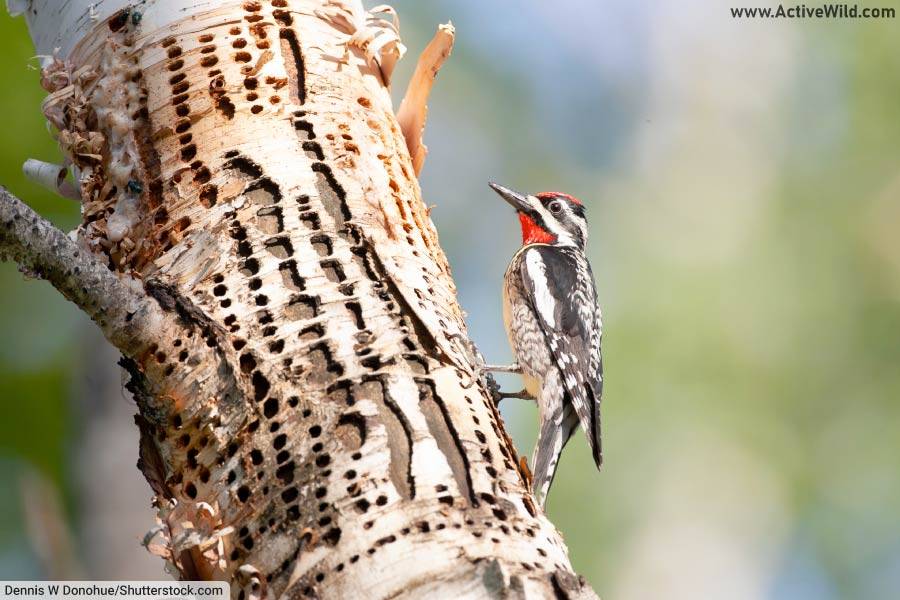
- Type of animal: Bird
- Family: Picidae
- Where found: North America
Sapsuckers are a group (the genus Sphyrapicus) of birds in the woodpecker family Picidae. Sapsuckers are found in forests in North America, where they feed on tree sap obtained by drilling holes in tree trunks with their powerful bills.
The rows of small, circular holes drilled by sapsuckers can eventually cause a tree to die. As well as sap, the omnivorous sapsuckers also feed on insects.
Discover More With Active Wild
- You can find out more about birds on this page: Birds – The Ultimate Guide
- Discover different types of birds on this page: Types of Birds
- Test your knowledge of British birds with our free Android app: British Birds ID Quiz
- Test your knowledge of North American birds with our free Android app: North American Birds ID Quiz
Sea Turtles
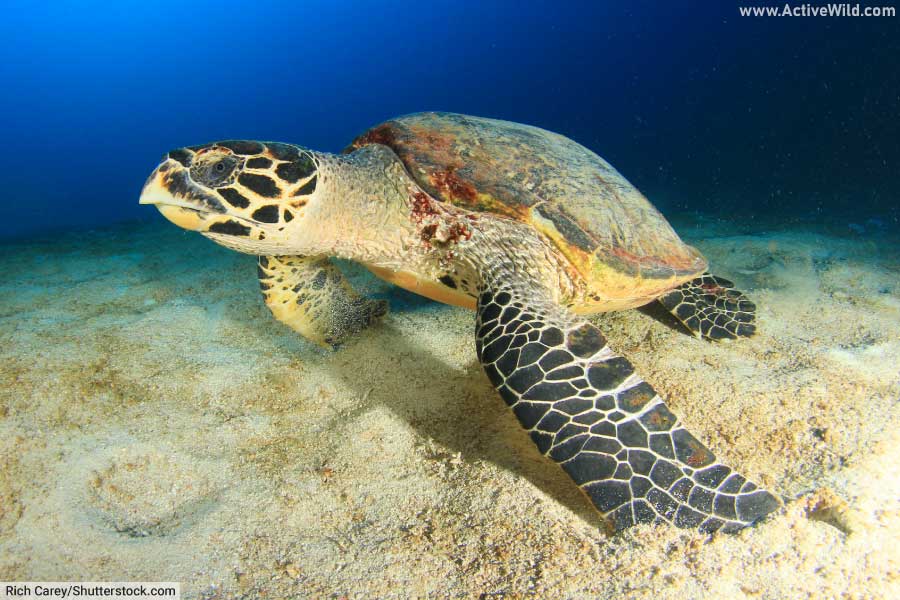
- Type of animal: Reptile
- Order: Testudines
- Where found: Oceans worldwide
Sea turtles are seven species of turtles evolved to live in the ocean. Sea turtles are migratory, moving between their mating and feeding grounds. Some sea turtles migrate thousands of miles in a year and return to the very beach on which they hatched.
During the breeding season, females emerge from the water, build nests, lay their eggs and return to the sea. Later, when the eggs hatch, the infant turtles instinctively make their way into the sea and fend for themselves. Male sea turtles never again set foot on land.
The loggerhead, olive ridley, Kemp’s ridley and hawksbill sea turtles are all omnivores, eating a wide variety of sea plants, invertebrates, and fish.
The green sea turtle is primarily herbivorous once reaching adulthood, and both the leatherback and flatback sea turtles are primarily carnivorous, with the former preying mainly on jellyfish.
Discover More With Active Wild
- You can find out more about sea turtles on this page: Sea Turtles
- Discover different types of turtles on this page: Types of Turtles
Skunks
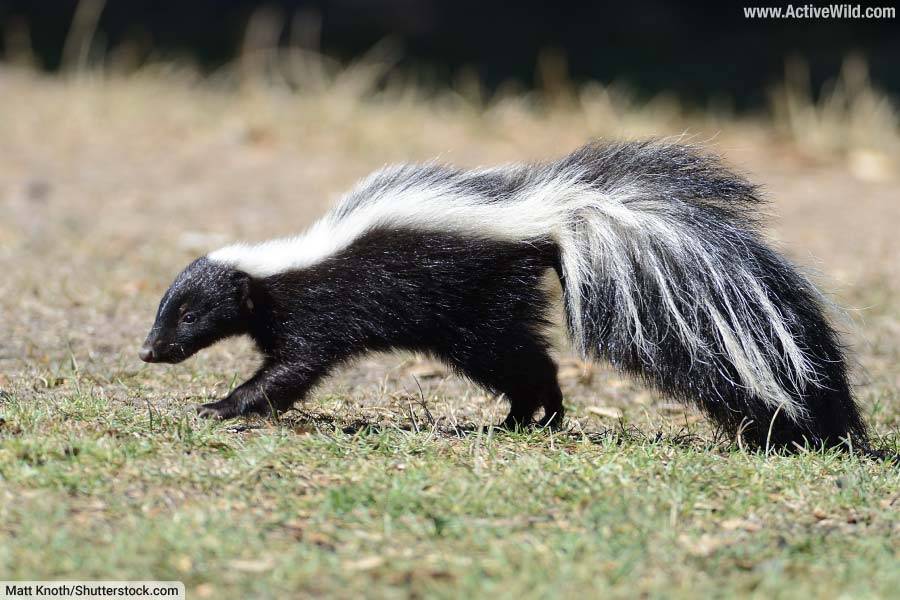
- Type of animal: Mammal
- Family: Mephitidae
Skunks, along with the two species of stink badger, make up the animal family Mephitidae.
All ten skunk species are found in the Americas (the two stink badgers are found in Southeast Asia).
Most skunks are black and white. The distinctive coloration acts as a warning; skunks are famously able to spray a foul-smelling liquid at potential attackers. This defense mechanism is even effective against bears.
Skunks are omnivores, feeding on plant matter such as fruit, roots and leaves, and animals such as worms, insect larvae, bees, eggs and small vertebrates.
Discover More With Active Wild
- You can see more North American animals on this page: North American Animals
- You can see more black and white animals on this page: Black and White Animals
Sloth (Two-Toed)
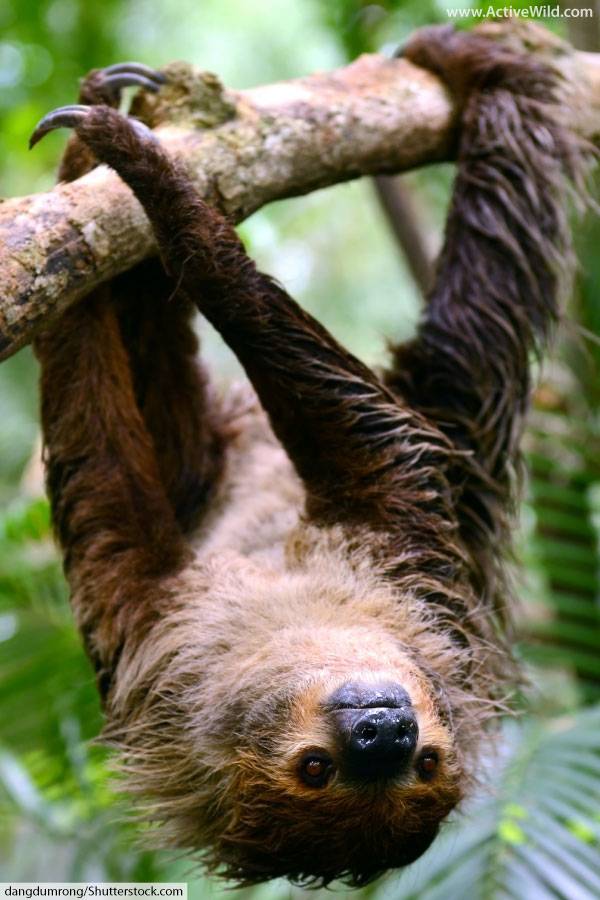
- Type of Animal: Mammal
- Suborder: Folivora
Sloths are slow-moving, arboreal (tree-dwelling) animals that have evolved to hang upside-down from branches.
Two of the six living sloth species – Linnaeus’s two-toed sloth (Choloepus didactylus) and Hoffmann’s two-toed sloth (Choloepus hoffmanni) are “two-toad sloths” of family Choloepodidae and genus Choloepus.
(The remaining four species are “three-toad sloths” of family Bradypodidae and genus Bradypus.)
Two-toed sloths have two toes on their forelimbs, three-toed sloths have three. All sloths have three toes on their hind limbs.
Whereas three-toed sloths are primarily herbivorous, the two-toed sloths are omnivores, eating insects, small vertebrates and carrion as well as leaves and other plant material.
Discover More With Active Wild
- You can find out more about sloths on this page: Sloth Facts
- You can see more rainforest animals on this page: Rainforest Animals List with Pictures & Facts
- You can see more South American animals on this page: South American Animals
Squirrel Monkeys

- Type of animal: Mammal
- Family: Cebidae
- Where found: Central America, South America
Squirrel monkeys are New World monkeys of genus Saimiri. Eight species are currently recognized.(source)
These small, arboreal (tree-dwelling) primates reach a maximum body length of around 35 cm / 14 cm, with a tail around the same length.
Surrounding the mouth of a squirrel monkey is a patch of dark, hairless skin, and surrounding the eyes is an area of white fur, giving the face a “skull-like” look.
Fruit and insects make up the bulk of the diet of these omnivorous animals.
Discover More With Active Wild
- You can find out more about monkeys on this page: Monkeys – The Ultimate Guide
- Discover different types of monkeys on this page: Types of Monkeys
- You can find out more about primates on this page: Primates – Ultimate Guide
Virginia Opossum
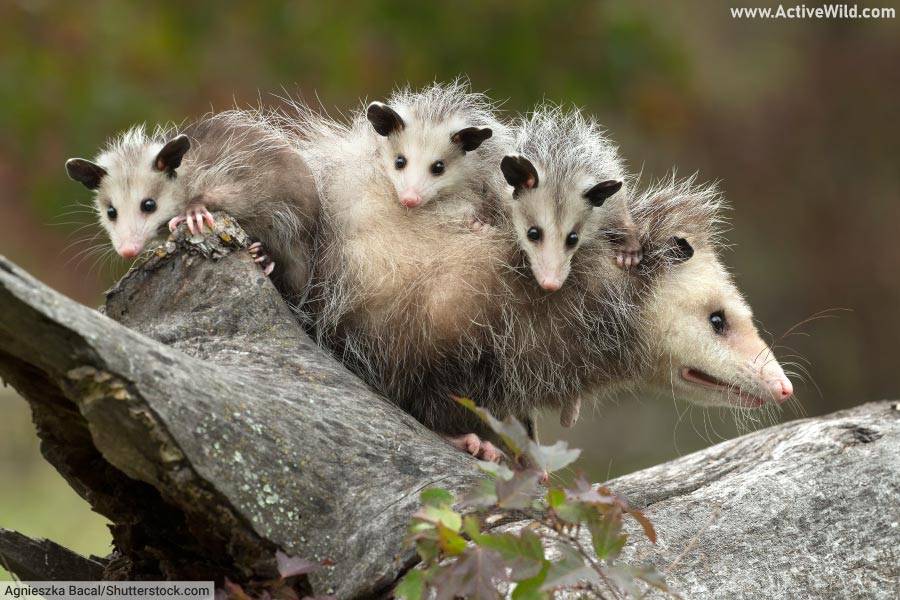
- Scientific name: Didelphis virginiana
- Type of animal: Mammal (marsupial)
- Family: Didelphidae
- Where found: North America (including Central America)
- Conservation status: Least Concern
The Virginia opossum is a cat-sized North American marsupial. The species is found from Costa Rica to southern Canada, and is the only marsupial found north of Mexico.
Marsupials are mammals whose young are born in a relatively underdeveloped state. Infant marsupials, which are known as “joeys”, complete their development in a pouch in the mother’s body.
Virginia opossum infants emerge from their mother’s pouch after around ten weeks. They are then carried on the mother’s back until able to fend for themselves.
The omnivorous Virginia opossum feeds feed mainly on insects, with other animals (both vertebrate and invertebrate) and a variety of plant material making up the rest of its diet.
Discover More With Active Wild
- You can see more North American animals on this page: North American Animals
- You can see more marsupials on this page: Types of Marsupials
Warthog
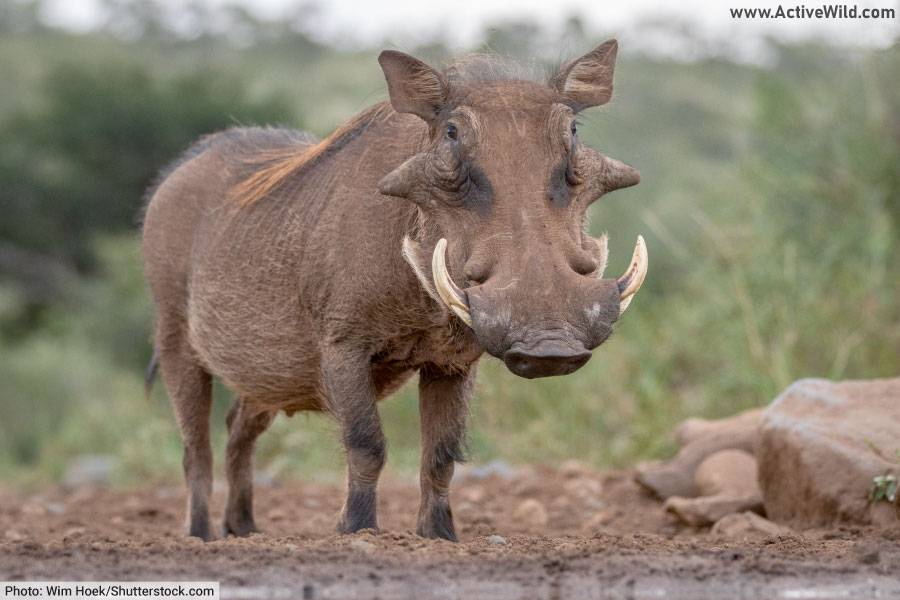
- Class of animal: Mammal
- Family: Suidae (the pig family)
- Genus: Phacochoerus
- Conservation status (both species): Least Concern
There are two warthog species: the common warthog Phacochoerus africanus, which is found across much of sub-Saharan Africa; and the desert warthog Phacochoerus aethiopicus, which is found in arid scrublands in Eastern Africa.
Both warthogs are members of the pig family, Suidae. Like other pigs, warthogs are omnivorous. They graze on grass, dig in the ground for roots and bulbs, and eat insects and carrion.
A warthog’s wide snout helps it to burrow and root around for food in the ground. Its four tusks are elongated teeth that curve upwards out of the mouth. They are used as weapons for fighting other warthogs and predators.
Discover More With Active Wild
- You can find out more about the common warthog on this page: Common Warthog Facts
- You can see more ugly animals on this page: Ugly Animals List with Pictures & Facts
- You can see more African animals on this page: African Animals
Wild Boar
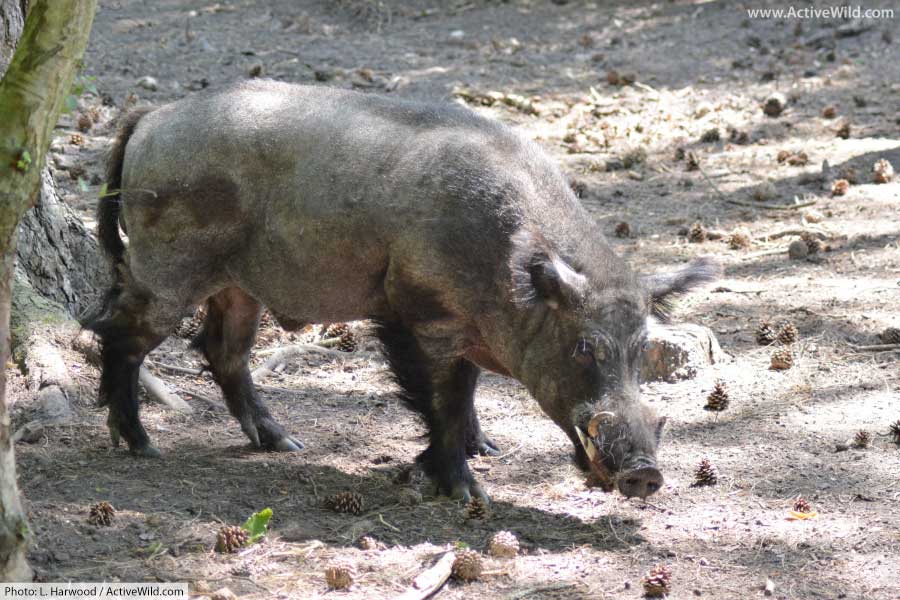
- Type of Animal: Mammal
- Family: Suidae
- Scientific Name: Sus scrofa
- Conservation Status: Least Concern
- Where found: Europe, Asia, North Africa
The wild boar is a species of wild pig belonging to the pig family, Suidae. It is found across much of Europe and Asia, and its range extends southwards into northern Africa.
Primarily a forest animal, the wild boar is also found in habitats as varied as grasslands and semi-deserts, although it prefers habitats with some tree cover.
The boar’s large head makes up one-third its total body length, which can reach up to 1.5 m / 4.92 ft. Males are significantly larger and heavier than females. The canine teeth of the male protrude from the mouth, forming short tusks.
Male boars are typically solitary, while females live in small groups known as “sounders”.
The wild boar is a highly-adaptable omnivore that will eat a wide variety of plant and animal matter.
Discover More With Active Wild
- You can see more European animals on this page: European Animals
- You can find out more about mammals on this page: Mammals – The Ultimate Guide
- Discover more forest animals on this page: Forest Animals
Discover More With Active Wild
- You can see a list of herbivorous animals on this page: Examples of Herbivores with Pictures & Interesting Facts
- Find out more about the animal kingdom on this page: Animals
- Discover the different types of animals: Types of Animals
- Discover animals from all around the world on this page: Animals Around The World
- Discover animals that live in different habitats on this page: Animal Habitats
The post Examples Of Omnivores – Omnivorous Animals List With Pictures & Interesting Facts appeared first on Active Wild.